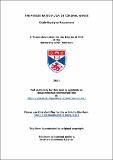The period ratio P₁/2P₂ in coronal waves
Abstract
Increasing observational evidence of wave modes brings us to a closer understanding of the solar corona.
Coronal seismology allows us to combine wave observations and theory to determine otherwise unknown
parameters. The period ratio, P₁/2P₂, between the period P₁ of the fundamental mode and the period P₂ of
its first overtone is one such tool of coronal seismology and its departure from unity provides information
about the structure of the corona.
In this thesis we consider the period ratio P₁/2P₂ of coronal loops from a theoretical standpoint. Previous
theory and observations indicate that the period ratio is likely to be less than unity for oscillations of
coronal loops. We consider the role of damping and density structuring on the period ratio.
In Chapter 2 we consider analytically the one-dimensional wave equation with the inclusion of a generic
damping term for both uniform and non-uniform media. Results suggest that the period ratio is dominated
by longitudinal structuring rather than damping.
In Chapter 3 we consider analytically the effects of thermal conduction and compressive viscosity on the
period ratio for a longitudinally propagating sound wave. We find that damping by either thermal conduction
or compressive viscosity typically has a small effect on the period ratio. For coronal values of thermal
conduction the effect on the period ratio is negligible. For compressive viscosity the effect on the period
ratio may become important for some short hot loops.
In Chapter 4 we extend the analysis of Chapter 3 to include radiative cooling and find that it too has a
negligible effect on the period ratio for typical coronal values. As an extension to the investigation, damping
rates are considered for thermal conduction, compressive viscosity and radiative cooling. The damping
time is found to be optimal for each mechanism in a different temperature range, namely below 1 MK for
radiative cooling, 2 − 6 MK for thermal conduction and above 6 MK for compressive viscosity.
In Chapter 5 we consider analytically the period ratio for the fast kink, sausage and n = N modes of a
magnetic slab, discussing both an Epstein density profile and a simple step function profile. We find that
transverse density structuring in the form of an Epstein profile or a step function profile may contribute to
the shift of the period ratio for long thin slab-like structures. The similarity in the behaviour of the period
ratio for both profiles means either can be used as a robust model. We consider also other profiles numerically
for the kink mode, which are found to be either slab-like or Epstein-like suggesting again that it is not
necessary to distinguish the nature of the density profile when considering the period ratio.
Type
Thesis, PhD Doctor of Philosophy
Collections
Except where otherwise noted within the work, this item's licence for re-use is described as Creative Commons Attribution 3.0 Unported
Items in the St Andrews Research Repository are protected by copyright, with all rights reserved, unless otherwise indicated.


